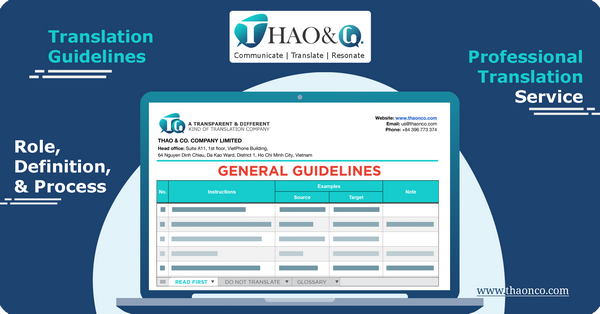When companies venture into a new market, what determines whether they succeed or fail? “When in Rome, do as the Romans do” – This is what most thriving businesses have taken to heart, with global content localization solutions being the key to their success.
Is there a grain of truth in that? Global content localization is a potential solution for bridging linguistic and cultural boundaries, gradually bringing companies closer to their intended audience. At Thao & Co., we invite you to explore the significance of content localization and how to guarantee excellent translation.
Global content localization is the meticulous process of adapting content to a specific target’s cultural and linguistic norms. Its principal aim is to minimize disparities and deviations in content when transitioning from the original language and culture to the target language and culture.
As such, localization extends beyond mere translation, necessitating a high level of harmonization between the translated content and the target audience and market.
Global content localization is widely used in a variety of projects:
The rationale behind our need for global content localization lies in appreciating each language’s unique beauty and distinctiveness, shaped by its rich cultural influences.
In high-context cultures, like those in Asian countries, language tends to be subtle and indirect. To fully grasp a message’s true essence and intended meaning, it is essential to consider the context in which the message is being communicated.
On the other hand, in low-context cultures such as the US and UK, messages are typically conveyed with clarity and directness.
Within every culture, individuals have subconscious programming about how to receive messages and their meaning. This presents both advantages and disadvantages for businesses entering new markets.
Products and services that are localized to be compatible with the local culture will be more readily accepted, while those that are not may be met with resistance or confusion.

An illustrative case of the importance of content localization can be found in Coca-Cola’s localization strategy for the Chinese market. In its initial entry into this vast market of billions, the brand labeled its carbonated soft drink “Kedou-kenla,” roughly translated to “Bite a wax tadpole.”
Recognizing the need for a cultural adjustment, Coca-Cola’s brand managers embarked on extensive research of 40,000 homonyms to eventually unveil a new name, “Kekou-kele,” conveying the delightful notion of “Happiness in the mouth,” and this meticulous localization effort led to Coca-Cola’s successful reception in this new market.
Customers become more open to the message as they identify culturally with a brand. Hence, global content localization is a crucial bridge, seamlessly uniting brands with their target customers across diverse cultures.
To excel in content localization, linguists must have a firm grasp of the source and target cultures, ensuring the delivery of the finest translations.
How can a professional translation agency uphold the quality of translations during the content localization process?
A set of Translation Guidelines at Thao & Co. typically includes:

In some cases, even when two phrases in different languages appear to express the same concept but deliver opposite messages.
In Japanese, the phrase “Aitsu-wa amai,” shares a semblance in denotation with the English expression “You are sweet.” However, these two phrases diverge significantly in interpretation. While “Aitsu-wa amai” implies “You are immature, naive, and weak,” “You are sweet” indicates a charming compliment.
This contrast highlights that translating idioms, metaphors, and slang requires the translator to understand deeply the language and how native speakers use these linguistic elements.
Furthermore, it emphasizes the importance of the translator’s adaptable creativity in choosing words that accurately capture the subtle meanings of the original expressions.
Back translation, a widely-used practice in translation, involves re-rendering a translated text into its original language. It allows a business to evaluate different creative translation options and decide on the best one that most accurately reflects their brand identity. In this case, back translation is a potent risk management tool, especially in creative translations of slogans, taglines, product names, and other major brand elements.
Back translation empowers translators to adapt the creative translation method to resonate with their audience while staying faithful to the source material.
Proofreading is a critical step once skilled linguistics have finished translating the project. This meticulous task is assigned to experienced language specialists who carefully examine the text for any word usage or stylistic errors to guarantee that the translated version maintains a smooth flow and seamless alignment with the original context. Therefore, strict proofreading forms the foundation for creating the highest quality final product.
Comprehensive localization testing is indispensable for specialized content localization projects such as adapting applications, websites, or software.
Functional testing verifies digital products such as apps, websites, and software operate as intended, while linguistic testing ensures that translations are culturally appropriate and visually compatible with the product interface.
To provide clients with the highest quality translations, professionals in the language industry must carefully evaluate a translation’s linguistic accuracy and functional relevance.

Global content localization is a “gateway” for multinational businesses to enter new markets. Choosing a competent content localization agency is essential for delivering high-quality and accurate translations.

Thao & Co. offers a systematic and optimized translation process that leverages cutting-edge technologies. Besides, our services are backed by:
Please visit Thaonco.com for more information or head over to our Get A Quote page to discuss your localization needs today.